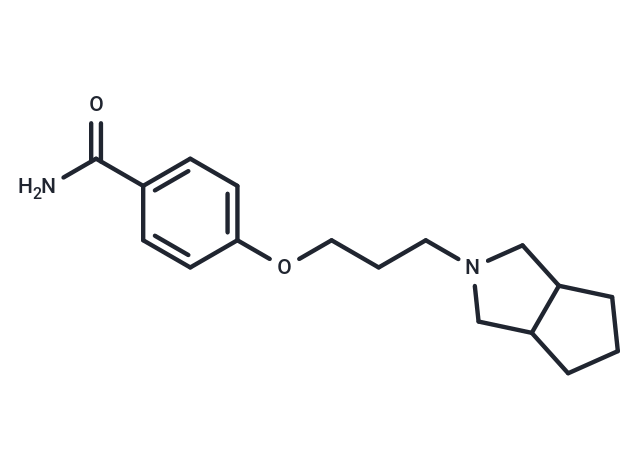Shopping Cart
- Remove All
 Your shopping cart is currently empty
Your shopping cart is currently empty

S 38093 is a brain-penetrant antagonist of the H3 receptor (Ki: 8.8/1.44/1.2 μM, for rat/mouse/human).

| Pack Size | Price | Availability | Quantity |
|---|---|---|---|
| 2 mg | $32 | In Stock | |
| 5 mg | $48 | In Stock | |
| 10 mg | $73 | In Stock | |
| 25 mg | $133 | In Stock | |
| 50 mg | $221 | In Stock | |
| 100 mg | $352 | In Stock | |
| 200 mg | $492 | In Stock | |
| 1 mL x 10 mM (in DMSO) | $48 | In Stock |
| Description | S 38093 is a brain-penetrant antagonist of the H3 receptor (Ki: 8.8/1.44/1.2 μM, for rat/mouse/human). |
| Targets&IC50 | H3 receptor (human):1.2 μM(Ki), H3 receptor (rat):8.8 μM(Ki), H3 receptor (mouse):1.44 μM(Ki) |
| In vitro | In cellular models, S 38093 can antagonize mice H3 receptors (KB: 0.65 μM) and suppress cAMP decrease induced by an H3 agonist (KB: 0.11 μM). In cells expressing a high H3 density, S 38093 is a moderate inverse agonist at the rat and human H3 receptors (EC50: 9/1.7 μM, respectively)[2]. |
| In vivo | In young adult mice, S 38093 (0.3/3?mg/kg/day, p.o., 28 days) markedly increases proliferation of progenitors in the DG of the hippocampus. S 38093 (0.3?mg/kg/day) markedly increases the number of DCX+?cells with tertiary dendrites. S 38093 (0.3/1/3?mg/kg) markedly increases cell survival, proliferation, and maturation in the DG of the hippocampus in aged mice relative to the vehicle. S 38093 (3?mg/kg/day, p.o., 28 days) increases cell proliferation and has a strong effect on cell survival, also increases the dendritic intersections in both genotypes, with a significant effect from 50 to 80 in APPSWETG?mice only. In aged mice, chronic administration of S 38093 (1/3?mg/kg/day, p.o., 28 days) reverses this age-dependent decrease in BDNF-IX/IV/I transcripts. In addition, S 38093 at three tested doses (0.3/1/3?mg/kg/day) increases VEGF transcripts compared to the vehicle-aged group[1]. |
| Animal Research | S 38093 is formulated in purified water.The context discrimination task consists of an 8-day contextual fear discrimination paradigm in which the mice have to learn to distinguish between a fearful shock context and a similar non-shock context. On day 1 the mice are only exposed to the training shock context, and on days 2-8 the mice are exposed to the shock and then non-shock context in that order each day. The mice are run through the context discrimination task starting at 10 am and ending at 2 pm and are then gavaged with vehicle or S 38093 at 4 pm each day. The drug and vehicle are always administered after behavioral testing to avoid possible acute effects of the drug on behavior. Learning is measured by the percent time the mice spent freezing and testing is terminated when percent freezing is consistently significantly different between the two contexts. The mice are tested after 29 days of drug treatment. Conditioning is conducted on one side of a Med-Associates shuttle box (ENV-010MC; 20.3?cm?×?15.9?cm?×?21.3?cm high) with a clear plexiglass wall, 3 aluminum walls and a stainless steel grid as a floor. Mouse behavior is recorded by digital video cameras mounted above the conditioning chamber. In training context A, mice are allowed to habituate in new cages outside the room and are then brought into the room in the new cages. The house fan and house light are turned on, the stainless steel grid is exposed, the plexiglass wall is up and a mild anise scent is used as an olfactory cue. The door to the sound dampening enclosure is shut for the duration of the trial. 180?s after the mice are placed in the training context, they are delivered a single footshock of 0.75?mA lasting 2?s. 15?s after the end of the footshock, the mice are placed back into their home cages. Non-alcoholic antiseptic wipes are used to clean the grids and catch trays in between trials. An hour later the mice are brought into the room in paper buckets and put into similar context B.The house fan and house light are turned off, the door of the enclosure is left ajar, plastic placemat sheets are put into the shuttle box to make a high-walled circular enclosure, the plexiglass wall is left down and a mild lemon scent is used as the olf |
| Alias | S-38093, S38093 |
| Molecular Weight | 288.38 |
| Formula | C17H24N2O2 |
| Cas No. | 862896-30-8 |
| Smiles | NC(=O)c1ccc(OCCCN2CC3CCCC3C2)cc1 |
| Relative Density. | 1.130 g/cm3 (Predicted) |
| Storage | Powder: -20°C for 3 years | In solvent: -80°C for 1 year | Shipping with blue ice. | |||||||||||||||||||||||||||||||||||
| Solubility Information | DMSO: 55 mg/mL (190.72 mM), Sonication is recommended. | |||||||||||||||||||||||||||||||||||
Solution Preparation Table | ||||||||||||||||||||||||||||||||||||
DMSO
| ||||||||||||||||||||||||||||||||||||

Copyright © 2015-2025 TargetMol Chemicals Inc. All Rights Reserved.